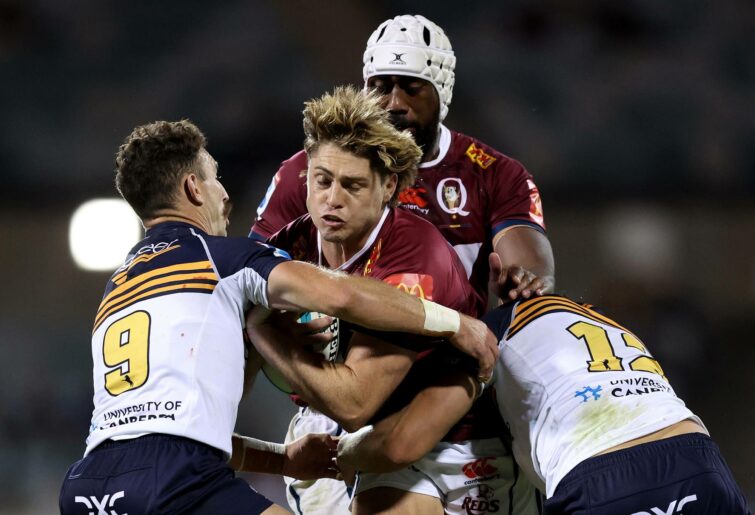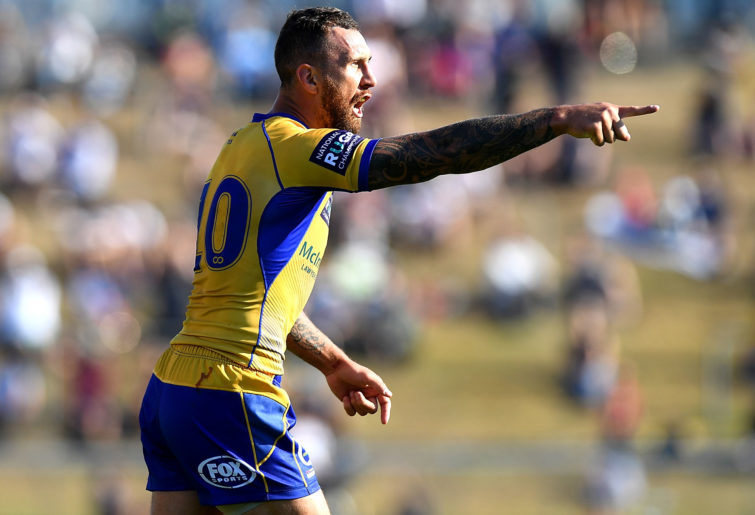McDave
new author
Roar Rookie
Opinion
With Super Rugby Pacific nearing its end, it’s a good time to consider the differences between Aussie and Kiwi off seasons.
In New Zealand, most players not selected for the All Blacks will head back to the NPC, a high-tempo national competition that serves as a breeding ground for its future rugby stars.
Meanwhile in Australia, players head back to club-land to face off against players who, while very good, are a level below the standard of the NPC.
Playing quality opposition has always been the argument for sticking with Super Rugby Pacific rather than going fully domestic, yet when the season ends that logic apparently goes out the window. While our Kiwi counterparts continue to play in a high-quality competition our players go back to club rugby and dull their proverbial blades.
Clearly, there is scope here to give players not selected for the Wallabies an opportunity to keep their skills sharp in the off-season.
What about the NRC?
The biggest flaw of the NRC was most of the ‘clubs’ in the comp were artificial creations (even if there was some long-forgotten history associated with them).
No one outside of rugby tragics really cared about “The Greater Sydney Rams” or “Brisbane City”. People were not tuning in, nor were they attending games.
There was also no tribalism attached to the teams, city-country derbies should have been a big deal. Instead, they didn’t even make the news.
Give the people what they want
Contrast the NRC with the one year of Super Rugby AU. The competition was between existing professional teams, with long standing rivalries and a higher quality of play.
Average attendance at games was roughly 9000 which is pretty good considering that NSW and Victoria were locked down for portions of the tournament and COVID-19 fears were rampant. Compare that with the NRC (about 1900) or Super Rugby Pacific (10,400 in 2022).
Additionally, the final between the Reds and Brumbies was a near sell-out affair with about 40,000 seats sold at Suncorp Stadium in Brisbane.
Obviously, there is demand for the product.

James O’Connor of the Reds is tackled by Nic White and Ollie Sapsford of the Brumbies (Photo by Mark Metcalfe/Getty Images)
How would a revived Super Rugby AU work?
I propose that Super Rugby AU would be revived as a 5 team, 11 round competition, with 10 weeks of head to head games plus 1 round finals between the top 2 teams.
Every team would play home & away against each other with associated bye weeks as part of the draw.
It would start two weeks after the Super Rugby Pacific finals, giving teams a minimum of two weeks rest before launching their Super Rugby AU campaign.
This roughly mirrors the Rugby Championship with games starting in early July and finishing on the same weekend as the AFL and NRL finals in September.
How would this help the Wallabies?
Let’s start with the most obvious advantage of this model.
By having a tier 2.5 competition running alongside the Rugby Championship, the Wallabies coaching team have a pool of players who are available, fit and playing a high level of rugby to select from should injury or form slumps strike players in the team.
Players dropped from the Wallabies would go back to super rugby level games to find form, while players not selected could demonstrate improvement through good performances against higher quality opposition.
How would this model help the Super Rugby Teams?
By giving the Super Rugby AU teams more game time, they would get something that the Kiwi teams don’t get – many more games together as a playing group.
This may sound like a bit of a reach, but there is evidence to support that teams which play together more often are more cohesive and as a result perform at a higher level. While Kiwi super rugby teams dissolve into NPC teams, Aussie Super teams would get more time together to address weaknesses and build upon strengths.
Players selected for the Wallabies would not be available for selection, so teams would be forced to use fringe players, improving depth within the squads, and giving those players more experience. Regular season Super Rugby players would also approach similar amounts of high-quality game time as their European counterparts.
Wallabies’ selection would also even up the competition, as form teams should lose more players to the Wallabies than teams that are out of form. So, while the Brumbies may have 12 of their players selected, the Force may only have 1, giving them both a quality and cohesion advantage going into the competition.
For Super Rugby coaches, the competition would give them time to analyse their Super Rugby Pacific campaign, and experiment or (gasp!) even innovate ahead of the next season.
Over time, this would help to improve both the depth and quality of our sides and hopefully make them more competitive with their Kiwi counterparts.
How would this model help Rugby Australia?
For this competition to be viable it needs to be both profitable and raise the profile of rugby in Australia.
From a profitability perspective, Super Rugby AU is already a product with clear market demand. However, given the timing of the new window, there will be competition for stadiums as both the NRL and Rugby Championship will be running at the same time.
Therefore, to save money, RA could look to host games in cheaper and more intimate local stadiums such as Leichhardt Oval (NSW) or traditional homes such as Ballymore (QLD). Alternatively, derbies could take place on a Thursday night to secure a larger venue for lower cost (and primetime TV slots).

Quade Cooper of Brisbane City calls out to his team mates during the round one NRC match between Brisbane and Fiji at Ballymore Stadium on September 2, 2017 in Brisbane, Australia. (Photo by Bradley Kanaris/Getty Images)
Ticket sales at the games could subsidise the cost of running the competition, while TV and advertising rights would likely be higher than the NRC as the teams who are competing are well-known and could be better marketed.
In terms of raising the profile of Rugby in Australia, having a competition running that consists of interstate derby’s week-in week-out would bring back the tribalism that is often lost with Super Rugby Pacific. Results would still be reported in the news, and state papers would have more Aussie content to write about.
Having a final in the same weekend as the NRL and AFL may sound like a dumb idea at first but could easily be spun to RA’s advantage.
Sport-related advertisers (read: gambling) already have massive marketing pushes around ‘finals season’ giving the NRL and AFL effectively free promotion for their products.
By putting a Super Rugby AU Final in the same weekend, you could easily see it getting wrapped up in the same promotional ecosystem (pick the winners trifecta?).
Smart placement of a final could ensure a sell-out game and high viewership. Both the NRL and AFL have finals that only take place in Sydney or Melbourne and always on Saturday (AFL) or Sunday (NRL). This leaves Perth and Brisbane as two sport mad cities with no chance of hosting a final in those sports.
It also leaves Friday night as a free prime-time sport slot. If RA guaranteed a final to take place in those cities, regardless of who was playing they could potentially fill Suncorp or Optus and take a massive pay day – every year.
Muscling into the ‘Finals Weekend’ would also bring more engagement – imagine every pub in Australia with the Super Rugby AU Final blaring on Friday night, as pubs cash in on ‘Finals Weekend’. TV advertising revenue would be higher as well, as advertisers would know that pubs are showing the game.
Finally, bringing back Super Rugby AU, would also give RA more negotiating power when the Super Rugby Pacific contract comes up for renewal. Any threat to go it alone would be backed up by a real local competition which would make our Kiwi friends think twice about making unreasonable demands.
Conclusion
Bringing back Super Rugby AU isn’t quite a no-brainer decision, but there is are clear upsides to reviving it.
Ultimately, RA must do something to support player development and in Super Rugby AU they have a product that already has market demand, tribalism, and name recognition.
With a ‘Golden Decade’ of rugby to come, RA should not squander this opportunity to build something that will last into the future and continue to support and grow the game we love for years to come.